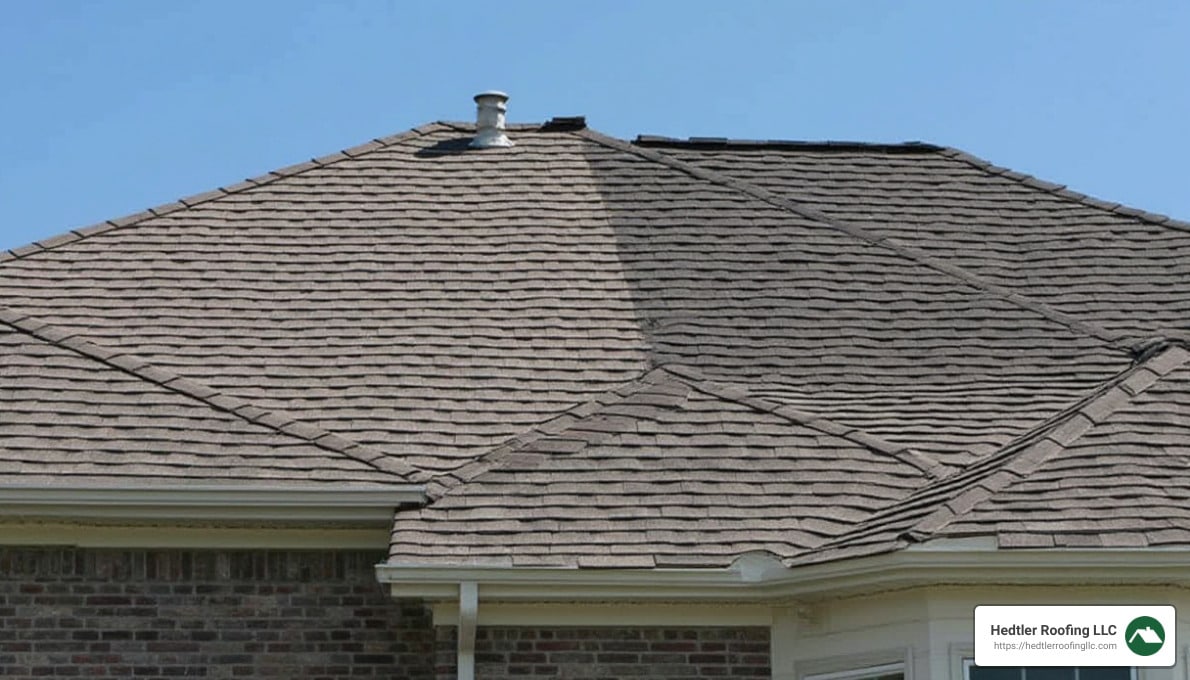Partial Roof Replacement: Top 5 Smart Budget Tips
Partial roof replacement can be a tempting choice for homeowners dealing with roof damage, cost concerns, and complex decision-making. If you’re weighing the options:
- Pros: Lower initial cost, quicker installation
- Cons: Aesthetic mismatch, potential durability issues
For those exploring partial roof replacement, it’s crucial to understand how each part of your roof works together as a shield for your home. Although fixing only the damaged area may seem more budget-friendly, there’s a broad impact on your home’s resilience against the elements.
By approaching this decision carefully, focusing on both immediate expenses and long-term protection, you can safeguard your property and its value.
I’m Jason Hedtler, and with years of experience in roof repair and replacement, I’ve guided many Massachusetts homeowners through decisions like these. My focus is ensuring you get the best care for your roof, whether through a full or partial roof replacement.

Partial roof replacement word list:
- roof replacement cost calculator
- average cost to tear off and replace roof
- how often should a roof be replaced
Can You Replace Half a Roof?
Yes, you can replace half a roof, but there are important factors to consider. Partial roof replacement might sound like a cost-effective solution, especially if you’re facing budget constraints. However, it comes with its own set of challenges and potential issues.
Roof Lifespan
When you replace only part of your roof, you end up with two sections that age differently. The new section will have a longer lifespan compared to the old one. This means you’ll be dealing with two different timelines for maintenance and eventual replacement.
Consider this: if the older section begins to fail, it can lead to leaks and other problems that might affect the newer section. This uneven aging can create a cycle of repairs and replacements, which might cost more in the long run.
Potential Issues with Partial Replacement
- Mismatched Materials: New shingles will look different from the old ones due to aging and weathering. Even if the same type and color of shingles are used, they won’t match perfectly. This can affect the curb appeal and potentially lower the value of your home.
- Increased Leak Risk: Partial replacements can make your roof more prone to leaks. The transition between new and old materials can create weak spots where water might seep in. This risk is especially high if the installation isn’t done with precision.
- Warranty Limitations: Most roofing materials come with warranties, but these are often limited when only part of the roof is replaced. Manufacturers typically offer better coverage for full roof replacements. This means you might end up with less protection against defects or failures.
Conclusion
In Massachusetts, where weather conditions can be harsh, it’s crucial to weigh the benefits and drawbacks of partial roof replacement. While it might save money upfront, the potential for mismatched materials, increased leak risk, and limited warranties are significant considerations.
If you’re thinking about a partial roof replacement, make sure to consult with a roofing expert. They can help assess your situation and guide you to the best decision for your home and budget.
Pros and Cons of Partial Roof Replacement
Partial roof replacement can be a viable option for homeowners in Massachusetts, especially when budget constraints are a concern. However, weigh the pros and cons before making a decision.
Budget-Friendly Option
One of the most significant advantages of partial roof replacement is its cost-effectiveness. By replacing only the damaged sections of your roof, you can save money compared to a full replacement. This approach is particularly appealing to those who need urgent repairs but are on a tight budget.
- Cost Savings: You only pay for the materials and labor needed for the specific area that requires attention, which can be significantly less than a full roof overhaul.
- Less Disruption: Since only a portion of the roof is being replaced, the process is generally quicker and less intrusive, allowing you to continue with your daily routine with minimal disturbance.
Mismatched Materials
Despite the cost benefits, partial replacements often lead to aesthetic and functional challenges due to mismatched materials.
- Visual Inconsistency: New shingles will likely stand out against the older ones, as the existing roof will have weathered over time. This can result in a patchwork appearance that might not be visually appealing.

- Potential for Performance Issues: The new materials may not perform uniformly with the old ones, potentially leading to varied wear rates and performance issues over time.
Limited Warranty
Another downside of partial roof replacements is the limitation in warranty coverage.
- Reduced Warranty Protection: Full roof replacements often come with comprehensive warranties that cover materials and workmanship. In contrast, partial replacements may offer limited warranties, leaving you with less protection against future issues.
- Warranty Overlap: If the new section is installed by a different contractor, you might end up with two separate warranties, one for each part of the roof. This can complicate matters if problems arise, as it may lead to disputes over responsibility.
Conclusion
While a partial roof replacement can be a cost-effective solution in some cases, it’s crucial to consider the potential drawbacks, such as mismatched materials and limited warranty coverage. Homeowners in Massachusetts should consult with a roofing expert to determine the best course of action based on their specific needs and circumstances.
When is Partial Roof Replacement Appropriate?
Localized Damage
A partial roof replacement is a smart choice when damage is confined to one specific area. For instance, if a tree limb falls and affects only a small section, replacing just that part can be efficient. This approach targets the problem without disturbing the rest of the roof.
Budget Constraints
Sometimes, a full roof replacement isn’t feasible due to financial limitations. In such cases, focusing on the damaged portions can stretch your budget further. That while this saves money upfront, it might mean facing additional repairs sooner than with a full replacement.
- Immediate Savings: You only purchase materials and labor for the affected area, which can significantly cut costs.
- Future Considerations: Be prepared for potential additional repairs, as the older sections continue to age.
Short-Term Ownership
If you plan to sell your home soon, investing in a full roof replacement might not make financial sense. A partial roof replacement can fix immediate issues, improve the home’s appearance, and potentially increase resale value without a hefty investment.
- Quick Fix: Addressing visible damage can improve curb appeal and make the home more attractive to buyers.
- Long-term Views: For long-term homeowners, a complete replacement could be more cost-effective over time, avoiding repeated repairs.
While a partial approach can be suitable in these scenarios, it’s crucial to consider the long-term implications. Massachusetts homeowners should weigh the immediate benefits against potential future costs and consult with roofing experts to ensure they make the best decision for their situation.
Frequently Asked Questions about Partial Roof Replacement
Can you replace only part of a roof?
Yes, you can replace only part of a roof. This is often called a partial roof replacement. It’s a good option when damage is localized. For instance, if a storm knocks off a few shingles or a tree branch damages a small section, you can replace just that part. This approach can be cost-effective because you only pay for the materials and labor needed for the damaged area. However, it’s important to ensure that the new section matches the existing roof to maintain a uniform appearance.
What are the risks of partial roof replacement?
While a partial roof replacement might save money initially, there are risks involved.
- Leaks: Different sections of the roof might age at different rates, leading to uneven wear. This can create weak spots where water can seep in, causing leaks and water damage.
- Structural Issues: If the older sections of the roof are already weakened, leaving them intact while replacing only a part might compromise the roof’s overall structure. This could lead to more serious problems down the road.
- Mismatched Materials: Finding materials that perfectly match the existing roof can be challenging, leading to a patchy appearance. This might not be ideal if you’re concerned about the visual appeal of your home.
Is partial roof replacement covered by insurance?
Insurance coverage for a partial roof replacement can vary. Typically, if the damage is due to a covered event like a storm, your homeowners insurance might help cover the costs. For example, if a storm causes shingles to blow off, insurance may cover that specific repair. However, damage due to regular wear and tear or lack of maintenance is usually not covered.
- Storm Damage: Most policies cover damage from unexpected events like storms, but it’s crucial to check your policy details and understand any exclusions.
- Insurance Claims: Document the damage thoroughly with photos and notes. Contact your insurance company promptly to report the damage and start the claims process.
Understanding your insurance policy and its coverage can help you make informed decisions about whether a partial roof replacement is the right choice for your situation. Massachusetts homeowners should consult with insurance experts and roofing professionals to steer these decisions effectively.
Conclusion
At Roof Experts, we understand that Massachusetts homeowners face unique challenges when it comes to roof repairs and replacements. Our team, with over 20 years of experience, is dedicated to providing expert advice and high-quality workmanship to ensure your home is protected and looks its best.
When considering a partial roof replacement, it’s important to weigh the pros and cons carefully. While it can be a budget-friendly option, especially for localized damage, there are potential risks like mismatched materials and structural issues. Our experts are here to help you steer these decisions, providing detailed inspections and custom solutions that fit your needs and budget.
We believe in empowering our clients with knowledge and options. Whether you’re dealing with storm damage or planning for short-term ownership, our team can guide you through the process, ensuring that all your roofing needs are met with precision and care.
For more information on how we can help with your roofing needs, visit our Roof Replacements page. We are committed to serving the Franklin and Bellingham areas with the best possible roofing solutions, keeping your home safe and secure for years to come.


